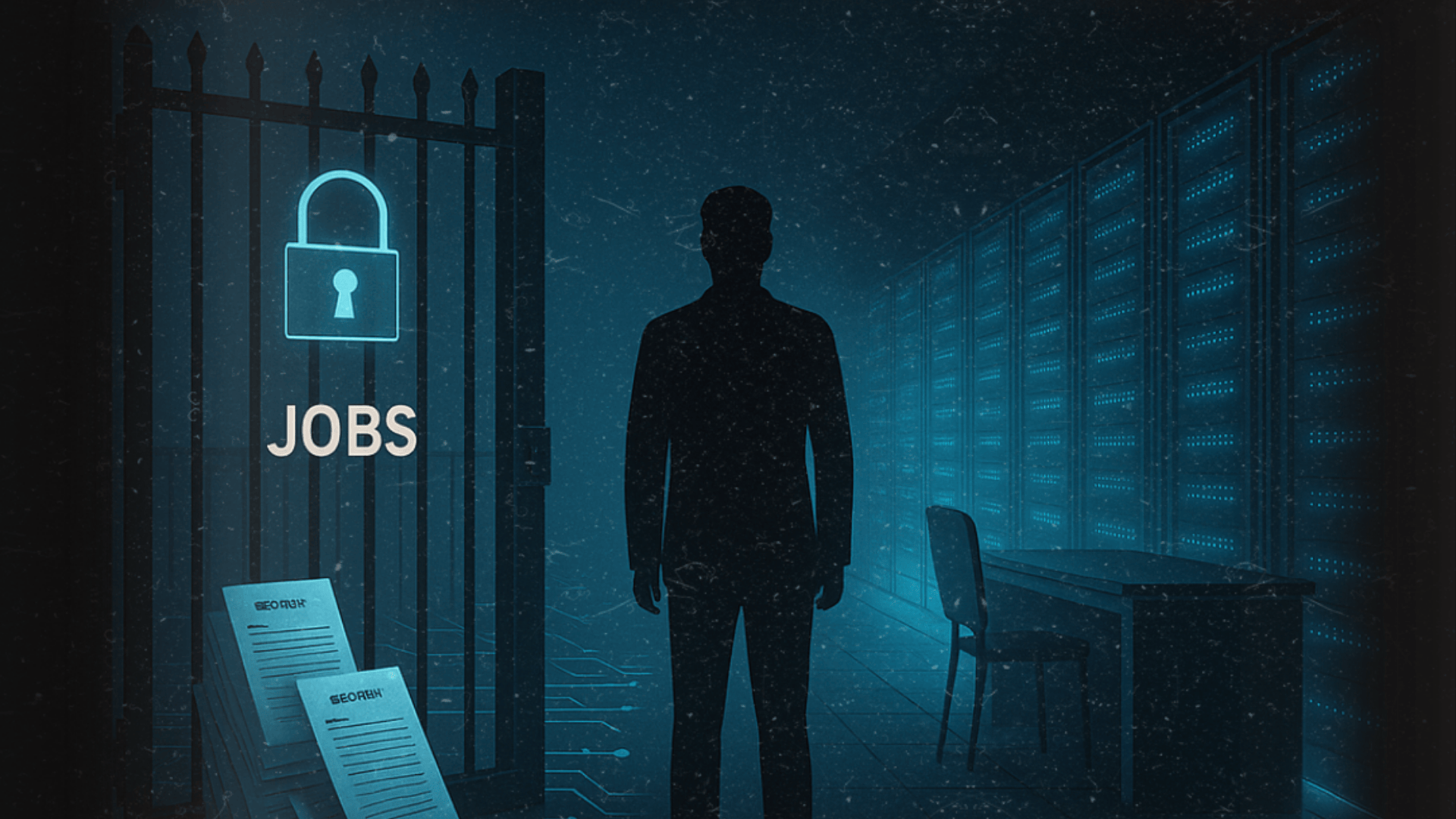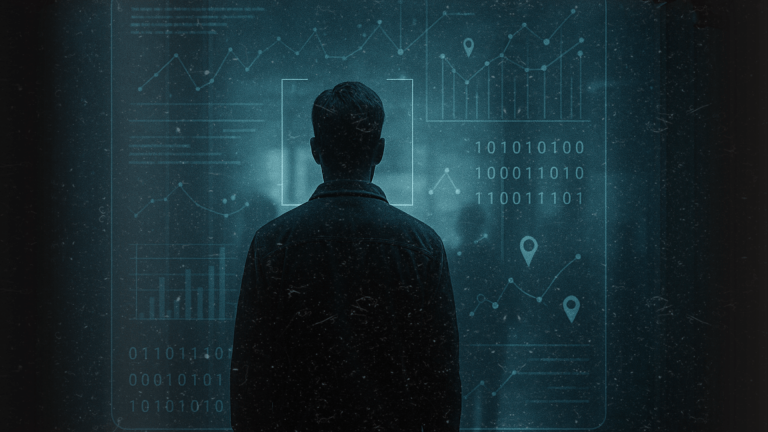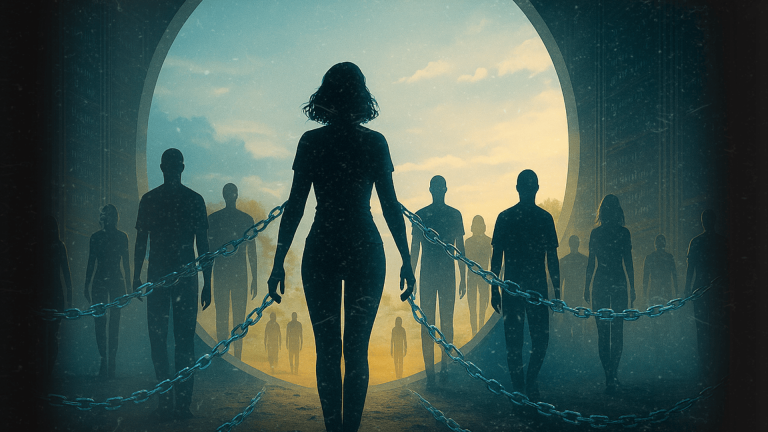Locked Out and Left Behind: The Human Cost of AI Hiring and Automation
Sarah’s resume was never seen. Michael’s job vanished overnight. Both were casualties of AI hiring and automation. In our latest blog, I explore how invisible systems are reshaping work and what it will take to reclaim the human value no machine can replace.
Algorithms are changing who gets hired, who keeps their job, and what human work is worth.
Sarah had everything going for her. Ten years of marketing experience, glowing references, and a portfolio that matched the role she was applying for. After five years caring for her dad, she was ready to jump back into her career. She sent out her resume and waited.
And then… nothing.
No rejection. No call. Not even a “thanks, but no thanks.” Just silence.
Sarah assumed the gap in her work history was the problem. But the truth was harder to see. A human never even looked at her name.
Now picture Michael. He had been working in customer support for years. He wasn’t just good at the job; he loved it. He was the kind of person who could calm down an angry caller in minutes or notice a billing error no one else had caught. His desk was full of photos from grateful customers, many of whom had become like family.
And then one day, a meeting. Salesforce, the company he worked for, announced that it was cutting 4,000 jobs. Their own AI was now handling half of all customer conversations. The work didn’t vanish. The people did.
Two different stories. Two different people. But really, they’re two sides of the same problem. For some, hiring algorithms lock the door before you ever step inside. For others, AI automation walks you out.
This blog builds on themes we’ve been exploring across The Xenessa Project. If you missed our last piece, Recognizing + Breaking the Algorithm’s Spell, it looks at how collective resistance begins when we stop letting algorithms decide for us.
Algorithmic Hiring and ATS Gatekeeping
What’s happening to Sarah is called algorithmic hiring or algorithmic gatekeeping.
Most large companies use Applicant Tracking Systems (ATS) to scan resumes. These systems don’t actually read them the way a person does. They hunt for keywords, job titles, degrees, or software names. Miss a word and your years of experience disappear.
And ATS is just one piece of the puzzle. Credit algorithms decide if you qualify for a loan. Housing algorithms rank your “desirability” for an apartment. Each one is marketed as efficient and fair. What they actually deliver is invisible discrimination on a massive scale.
AI Job Loss and the Automation Trap
Michael’s story shows the other side of the problem: automation as replacement.
For decades, we’ve been told that technology frees us to focus on higher-value work. But in reality, companies use automation to cut costs by cutting people.
Your great-grandfather may have left the farm to work in a factory. Your grandfather might have watched his factory job move overseas. And now? Machines aren’t just lifting heavy boxes. They’re answering phones, writing reports, and making decisions that used to be ours.
To be fair, automation has also brought real benefits. It has made dangerous factory work safer, eliminated tedious tasks, and in some cases freed people to focus on more creative or strategic work. But for many workers, that promise has not materialized. Instead, it has meant replacement.
This is the future of work with AI, and it is arriving faster than most of us imagined.
AI Hiring Bias in Research
This isn’t just a feeling. It’s being exposed by the data.
- Harvard’s 2023 study found that 27 million “hidden workers” are excluded every year because their resumes don’t match the algorithm. Veterans, caregivers, and individuals with non-linear career paths are often overlooked because they don’t fit a machine’s predefined pattern.
- In 2018, Amazon scrapped its own recruiting tool after it started downgrading resumes that contained the word “women’s.” Trained on data reflecting decades of male-dominated hiring, what was presented as neutral turned out to be history, repeated and amplified.
- ProPublica’s 2016 Machine Bias investigation showed the same trend in the justice system. Risk assessment tools were far more likely to label black defendants as “high risk,” even when their records matched white defendants. Algorithms don’t start from zero. They inherit our prejudice along with our data.
Research on Automation and the Future of Work
On the job side, the evidence is also compelling.
- Oxford researchers Carl Benedikt Frey and Michael Osborne warned in 2013 that 47 percent of U.S. jobs were at risk of automation. A number that felt hypothetical, even alarmist, over a decade ago is now becoming a reality. The story of Salesforce is proving that.
- The World Economic Forum’s 2023 report predicts that by 2027, AI will displace 14 million jobs while creating 69 million new ones. On the surface, this sounds like a net gain. However, this statistic hides a crucial and painful truth: the vast majority of these new jobs require advanced technical skills that the displaced workers lack. This isn’t a simple job transfer; it’s a massive, societal-level transition that we are unprepared for.
- MIT economist Daron Acemoglu, in his 2022 study “Tasks, Automation, and the Rise in U.S. Wage Inequality,” warns of “so-so automation” – technologies that are beneficial for corporate profits but detrimental to workers, without significantly enhancing overall productivity. At Salesforce, customer satisfaction scores remained unchanged even as 4,000 jobs were eliminated. The spreadsheets call that efficiency. But for the people left behind, it’s just loss.
The Human Cost of AI in Hiring and Jobs
What hurts most is not the numbers. It’s what those numbers erase.
Sarah spent months thinking she wasn’t good enough. She blamed herself for the silence when the truth was simpler: her resume was missing two words, “growth marketing.” Ten years of real work erased by a filter she never even knew was there.
Michael lost more than his income. He lost his purpose and the sense of being useful. He lost the daily moments that gave his work meaning, things like a calm voice, a shared laugh, or a sigh of relief on the other end of the line. Customers still got answers. But something human disappeared.
And here’s where it gets even more concerning. People start reshaping themselves to fit the machine. Job seekers rewrite their resumes to include relevant keywords. People curate their online presence to look “algorithm-friendly.” Some even change zip codes to improve their chances of getting loans.
When you change yourself to please a system, you lose part of who you are. And the cruelest part? Most people never even know it happened.
How We Reclaim Human Value
So where do we go from here?
- Reclaim clarity. Let’s be honest. When thousands of jobs are cut, that isn’t just “streamlining.” It’s replacement. When millions of resumes never reach a person, that isn’t pure objectivity. It’s automated bias.
- Reclaim fairness. We can demand better systems. Some companies are shifting to skills-based hiring platforms, such as CodeSignal and TestGorilla, that test what people can actually do, rather than just what keywords they use. Others are allowing candidates to bypass filters with video introductions. However, and I cannot stress this enough, this is only a true solution if companies commit to a ‘human in the loop’ for their review. Without a firm guarantee that a person is watching, a video simply becomes another dataset for an AI to screen for keywords and tone, risking even deeper, more personal forms of bias.
- Reclaim value. Creativity. Empathy. Critical thinking. Mentorship. These so-called “soft skills” are the fundamental core of human work. Let’s create job descriptions and performance reviews that explicitly recognize and reward these invaluable competencies.
- Reclaim responsibility. If companies profit from automation, they must help workers transition. This means more than a severance package. It means funding robust retraining programs, apprenticeships, and new career pathways. It could even mean policy solutions like an “automation tax” that helps fund social safety nets or Universal Basic Income (UBI) to provide a floor for those caught in the transition.
Because here’s the truth: machines may take the tasks, but only humans can bring the meaning.
A Closing Reflection
Sarah and Michael’s stories aren’t just warnings. They’re reminders of what’s at stake.
So here’s a question for you. What’s one thing you bring to your work that no machine could ever replace?
Maybe it’s your ability to listen. Maybe it’s the way you calm people down. Maybe it’s your creativity, or the way you connect ideas that no one else sees.
Hold onto that. Protect it because that’s where your value really lives.
Next comes our Season 1 finale, where we bring Episodes 11 and 12 together. “Beyond Replacement and Reclaiming Human Value” will close this arc with a look at how AI can augment us rather than replace us and what it means to rediscover what makes us uniquely human.
Frequently Asked Questions (FAQs)
- How do Applicant Tracking Systems (ATS) affect job seekers?
ATS software scans resumes for specific keywords and formats. If your resume doesn’t match the algorithm, it may be filtered out before a human ever sees it. - What is algorithmic hiring bias?
Algorithmic hiring bias happens when AI hiring tools replicate societal prejudices found in their training data, excluding groups like women, caregivers, or minorities. - Will AI replace my job?
AI won’t replace all jobs, but many roles are at risk. Studies predict millions of jobs will be displaced, while new roles will be created in technical fields. The challenge is that most workers are not trained for these new jobs. - What human skills can’t be replaced by AI?
Empathy, creativity, judgment, and mentorship are uniquely human. Machines can handle tasks, but only humans bring meaning, care, and connection.








🎧 Listen to the Humans + Machines arc (Episodes 9 + 10): https://www.youtube.com/playlist?list=PL7c575uxRXhQkZMlHZxqc5exbMfGcqn0F
If you missed our last piece, Recognizing + Breaking the Algorithm’s Spell, it looks at how collective resistance begins when we stop letting algorithms decide for us.
🎧 If you enjoy listening, catch up with Arc 1: Outside the Algorithm (Episodes 1-8): https://www.youtube.com/playlist?list=PL7c575uxRXhRy51uxa_sVNMAUZYMQVQOf
https://shorturl.fm/Oc45u
https://shorturl.fm/7Ct89